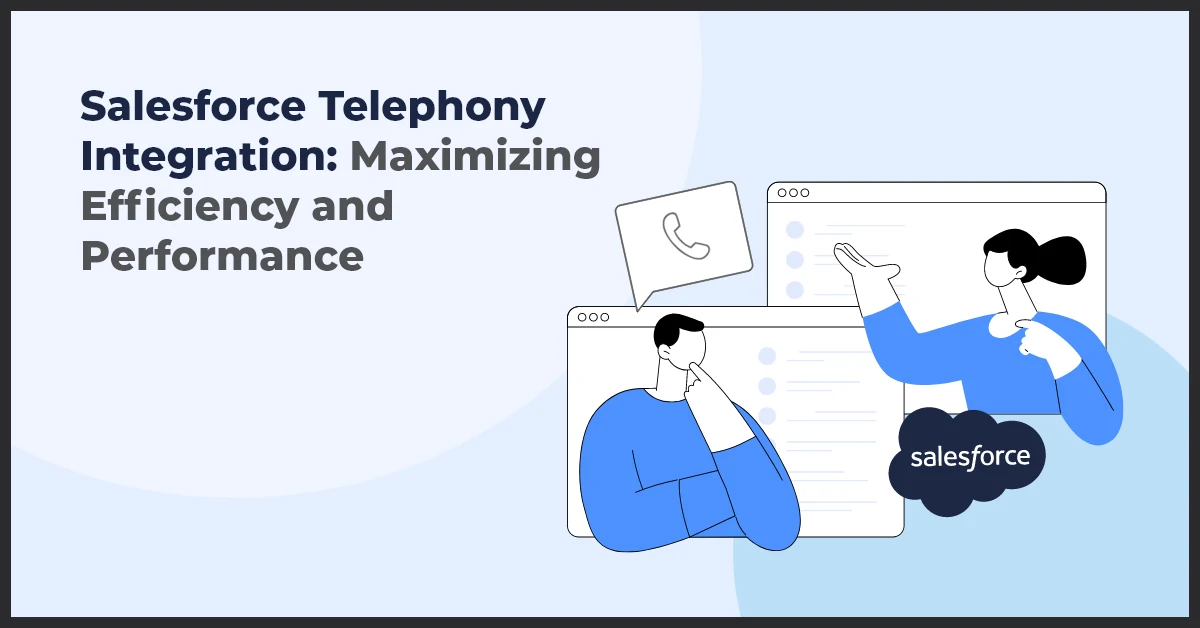Salesforce Telephony Integration: Maximizing Efficiency and Performance

Published on: November 28, 2023
Updated on: March 19, 2024
503 Views
- Salesforce
11 min read
A well-integrated telephony system can revolutionize the way businesses communicate and collaborate with their customers. Salesforce telephony integration refers to the process of seamlessly connecting your telephony systems with Salesforce CRM, providing a powerful solution that streamlines your customer interactions and enhances overall sales performance.
Integrating telephony systems with Salesforce CRM offers numerous benefits, such as improved productivity, enhanced customer satisfaction, and increased revenue. By bringing together crucial customer data and call information, sales representatives can access real-time insights, make informed decisions, and provide personalized experiences to every customer.
In this content plan, we will explore the various aspects of Salesforce telephony integration, including the technical implementation process, popular integration solutions, and best practices to maximize the benefits. Additionally, we will discuss how telephony integration can boost sales efficiency, improve customer service, and drive business growth. If you are looking to optimize your sales process and unlock the full potential of Salesforce CRM, this comprehensive guide is here to help.
Understanding Salesforce and Telephony Systems
A. Salesforce CRM Software
As a leading CRM platform, Salesforce offers a comprehensive range of features and functionalities that help businesses streamline their sales, marketing, and customer service processes.
- Overview of Salesforce as a leading CRM platform: Salesforce is widely recognized as one of the most powerful and innovative CRM solutions in the market. It provides businesses with a centralized system to manage and track customer interactions and activities.
- Key features and functionalities of Salesforce CRM software: Salesforce offers a wide array of features, including contact management, lead generation, opportunity tracking, email integration, and customizable dashboards. These features empower businesses to effectively manage their customer relationships and drive sales growth.
B. Telephony Systems
Telephony systems play a critical role in call center operations, enabling businesses to handle inbound and outbound calls efficiently. These systems facilitate seamless communication between customers and agents, leading to enhanced customer service experiences.
- Introduction to telephony systems and their role in call center operations: Telephony systems are communication platforms that enable voice-based interactions between customers and call center agents. They provide businesses with the necessary tools to handle phone calls, route calls to the appropriate departments, and manage call queues effectively.
- Explanation of different types of telephony systems, including cloud-based solutions: There are various types of telephony systems available, including traditional landline systems, Voice over IP (VoIP) systems, and cloud-based solutions. Cloud-based telephony systems have gained popularity due to their scalability, cost-effectiveness, and flexibility. They allow businesses to easily scale their telephony operations as their needs evolve.
Customer-centric Approach with Salesforce Telephony Integration
A. Customer Relationship Management (CRM) and Call Center Operations
When it comes to call center operations, customer relationship management (CRM) plays a crucial role. CRM systems enable businesses to effectively manage customer interactions, track leads, and monitor customer support activities. By integrating telephony systems with CRM, businesses can revolutionize their call center operations and provide enhanced customer service.
- Understanding the significance of CRM in call center operations: CRM systems allow call center agents to quickly access customer information, enabling personalized and efficient customer interactions. With a unified view of customer data, agents can offer tailored solutions and resolve issues promptly.
- Benefits of integrating telephony systems with CRM for enhanced customer service: By integrating telephony systems with CRM, businesses can capture call data, record customer interactions, and automatically link them to customer records. This enables agents to have a holistic view of customer history, leading to more informed conversations and improved customer satisfaction.
B. Sales and Customer Support Processes with Telephony Integration
Telephony integration enhances sales and customer support processes by streamlining communication channels and improving customer interactions.
- Detailed explanation of how telephony integration improves sales and customer support processes: With telephony integration, businesses can seamlessly connect their phone systems with CRM, allowing agents to make calls directly from CRM platforms. This eliminates the need for manual dialing and ensures accurate call data logging. Additionally, telephony integration enables automatic call routing, reducing wait times and increasing first call resolution rates.
- Examples of how communication channels integration enhances customer interactions: Integration of communication channels, such as voice, SMS, and email, enables businesses to provide customers with multiple options to interact. This flexibility enhances customer satisfaction as they can choose the most convenient channel to reach out. Moreover, integrating these channels with CRM ensures consistent and centralized customer data, providing agents with a complete picture of customer interactions.
Key Features and Functionalities of Salesforce Telephony Integration
A. Automatic Call Distribution (ACD)
Automatic Call Distribution (ACD) plays a crucial role in efficiently distributing incoming calls in a call center. It ensures that the right calls are routed to the right agents, based on predefined criteria such as agent availability or skillset. By automating the call handling and routing process, ACD improves response times, reduces wait times, and increases customer satisfaction.
Benefits of ACD in Salesforce telephony integration include:
- Efficient call handling and routing
- Reduced wait times for customers
- Improved agent productivity and efficiency
- Enhanced customer satisfaction and loyalty
B. Call Routing and Forwarding
Salesforce telephony integration offers advanced call routing and forwarding capabilities. Call routing ensures that incoming calls are directed to the most appropriate agent or department. This helps in improving the customer experience by ensuring that callers are quickly connected to the right person who can address their needs.
Examples of how call routing improves customer experience and reduces wait times include:
- Routing calls based on caller ID or contact information
- Routing calls based on language preferences
- Routing high-priority calls to senior agents
C. Interactive Voice Response (IVR) Systems
Interactive Voice Response (IVR) systems play a crucial role in automated customer interactions. With IVR systems, customers can use their telephone keypad or voice commands to interact with pre-recorded messages and perform actions such as accessing account information, paying bills, or scheduling appointments.
Benefits of IVR systems in Salesforce telephony integration include:
- Automated customer self-service options
- Gathering customer information through IVR menus
- Routing calls based on customer inputs in IVR menus
Integrating CRM and Telephony Systems
Salesforce AppExchange Telephony Integrations
Overview of AppExchange and its offerings for telephony integration
AppExchange is a platform provided by Salesforce that offers a wide range of apps and integrations to enhance the functionality of Salesforce CRM. With regards to telephony integration, AppExchange provides numerous options for Salesforce users to seamlessly integrate their telephony systems with Salesforce CRM.
CRM Integration with Telephony Systems
Exploring the benefits of integrating telephony systems directly with Salesforce CRM
Integrating telephony systems directly with Salesforce CRM can bring a myriad of benefits to businesses. By consolidating customer data and call information in one central system, businesses gain a holistic view of their customers and can deliver a more personalized and efficient customer experience.
Examples of how CRM integration enhances customer data management and call logging
When telephony systems are integrated with Salesforce CRM, customer data management becomes seamless. The integration allows for automatic synchronization of customer information, ensuring that all contact details, call history, and other relevant data are up to date and easily accessible.
Call logging is also greatly enhanced through CRM integration. Every incoming and outgoing call is automatically logged within Salesforce CRM, eliminating the need for manual entry. This eliminates data entry errors and ensures that all interactions are tracked and recorded accurately.
Moreover, CRM integration allows for a more efficient workflow. Agents can easily access customer information during a call, view past interactions, and provide personalized assistance. This improves efficiency, reduces call handling time, and enhances customer satisfaction.
Call Analytics and Reporting for Improved Service
A. Call Logging and Recording
Detailed explanation of call logging and recording capabilities in telephony integration
With Salesforce telephony integration, calls made or received through the telephony system can be logged and recorded. This powerful functionality allows businesses to keep a detailed record of all customer interactions. Every call can be tracked, including the date, time, and duration, as well as any notes or comments made during the call.
Additionally, call recording enables businesses to review conversations between agents and customers for quality control and training purposes. By capturing these interactions, organizations can analyze and identify areas for improvement in customer service. It also provides a valuable resource for resolving disputes or addressing customer concerns in the future.
Overall, call logging and recording capabilities offered by Salesforce telephony integration enhance transparency and accountability in customer interactions, ultimately leading to improved service delivery.
B. Call Analytics and Reporting
Overview of call analytics and reporting features in telephony integration
Call analytics and reporting features in Salesforce telephony integration provide valuable insights into the performance of customer service teams, as well as sales effectiveness. By analyzing data from calls, businesses can identify trends, patterns, and areas of improvement to optimize their sales and customer support strategies.
Through comprehensive reporting, businesses can track key metrics such as call volumes, average call duration, response times, and customer satisfaction ratings. These metrics enable organizations to assess the effectiveness of their customer service operations and make data-driven decisions to improve efficiencies.
Examples of how call analytics help in identifying trends and improving sales and customer support:
- Identifying peak call hours, allowing businesses to allocate resources effectively and ensure prompt customer service.
- Analyzing call durations to identify training needs or areas where agents may need additional guidance.
- Monitoring call-to-conversion ratios to measure the effectiveness of sales tactics.
- Tracking customer satisfaction ratings to identify areas for improvement and mitigate potential customer churn.
The Power of Cloud for Salesforce Telephony Integration
Cloud technology has revolutionized the way businesses operate, and when it comes to Salesforce telephony integration, the power of the cloud cannot be underestimated. By harnessing the capabilities of cloud-based telephony solutions, organizations can unlock a world of benefits and take their customer service to new heights.
A. Cloud-Based Telephony Solutions
Cloud-based telephony solutions have become increasingly popular in recent years, and for good reason. These solutions offer a multitude of advantages for businesses of all sizes and industries. Firstly, they eliminate the need for traditional hardware and physical phone lines, allowing for a more flexible and cost-effective telephony infrastructure.
Furthermore, cloud-based telephony integrates seamlessly with Salesforce, providing a unified platform for customer interactions and data management. This integration allows sales and support teams to have real-time access to customer information, enabling personalized and efficient service.
B. Customer Data Management in the Cloud
One of the key benefits of cloud-based telephony is its ability to enhance customer data management. With traditional, on-premise telephony systems, customer data is often siloed and fragmented across various platforms. This can lead to inconsistencies, data duplication, and difficulty in accessing accurate information.
However, with cloud-based telephony, customer data is stored centrally in the cloud, ensuring a single source of truth for all customer interactions. This improves data accuracy, facilitates streamlined workflows, and enables teams to have a holistic view of each customer's journey.
Moreover, storing customer data in the cloud allows for seamless access and updates. Sales and support teams can retrieve customer information from anywhere, at any time, enabling them to provide personalized and responsive service regardless of their physical location.
Overall, when it comes to Salesforce telephony integration, harnessing the power of the cloud opens up a world of possibilities. From cost savings and flexibility to improved data management and customer service, cloud-based telephony solutions are a game-changer for businesses striving to deliver exceptional customer experiences.
Conclusion
Throughout this content, we've explored Salesforce Telephony Integration and its various aspects. Let's recap the main points covered:
- Introduction to Salesforce Telephony Integration: We introduced the concept of integrating telephony systems with Salesforce CRM.
- Understanding Salesforce and Telephony Systems: We delved into the workings of Salesforce and telephony systems to understand how they can be integrated.
- Customer-centric Approach with Salesforce Telephony Integration: We highlighted the benefits of a customer-centric approach achieved through telephony integration.
- Key Features and Functionalities of Salesforce Telephony Integration: We explored the essential features and functionalities that Salesforce telephony integration offers.
- Integrating CRM and Telephony Systems: We discussed the process and benefits of integrating CRM and telephony systems.
- Call Analytics and Reporting for Improved Service: We emphasized the significance of call analytics and reporting in enhancing customer service.
- The Power of Cloud for Salesforce Telephony Integration: We explored the advantages of using cloud technology in Salesforce telephony integration.
It's important to recognize the vital role that telephony integration plays for Salesforce users and call centers. By seamlessly integrating CRM and telephony systems, businesses can enhance their customer service, streamline communication processes, and improve overall efficiency.
If you want to delve deeper into Salesforce telephony integration and unlock its full potential, we encourage you to explore relevant resources such as Salesforce's official documentation, case studies, and expert blogs. These resources will provide you with valuable insights and actionable knowledge to optimize your telephony integration experience.
Remember, this content plan serves as a comprehensive structure that can be further expanded with relevant information, examples, and case studies to provide readers with even more valuable insights.



